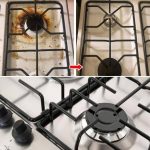ADVERTISEMENT
Glass stoves are not as sturdy as traditional gas stoves, and they are more likely to crack or break if you place heavy pots and pans on them. You should use lightweight pots and pans on your glass stovetop to avoid damaging it. Avoid using cast iron or any other cookware that is heavy and has a rough or uneven bottom.
3. Slide pots and pans onto the stove
Dragging pots and pans across the glass stovetop can scratch and damage the surface. Always lift cooking utensils instead of dragging them, especially when they are full of food or liquid.
5. Cooking with dirty kitchen utensils
Cooking with dirty cookware can leave residue and grime on the stovetop, which can damage the surface. Always make sure your cookware is clean before using it on a glass stovetop.
6. Place a hot lid face down on a glass stove
Placing a hot lid face down on a glass stove can be a dangerous habit. The sudden change in temperature may cause the glass cooktop to crack or shatter, which may result in serious injury or property damage.
Indeed, glass is a poor conductor of heat. So when a hot object is placed on it, the glass can be stressed and weakened. When the hot lid is placed face down on the glass cooker, it can create a sudden and significant temperature change, which could cause the glass to break.
To avoid this danger, it is important to always place hot lids on a heat-resistant surface, such as a trivet or countertop that can withstand high temperatures. It’s also a good idea to let the lid cool for a few minutes before placing it on any surface to reduce the risk of thermal shock.
7. Ignoring Cracks or Chips
If you notice a crack or chip on your glass cooktop, don’t ignore it. Even small cracks or chips can develop over time and cause the cooker to shatter. Replace the range immediately or have it repaired by a professional.
ADVERTISEMENT




